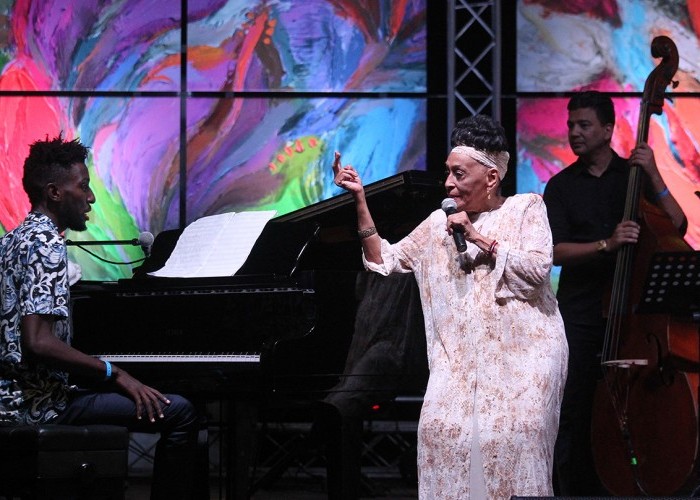Oct 28, 2025 10:47 AM
In Memoriam: Jack DeJohnette, 1942–2025
Jack DeJohnette, a bold and resourceful drummer and NEA Jazz Master who forged a unique vocabulary on the kit over his…

Omara Portuondo performs at the Dominican Republic Jazz Festival.
(Photo: Courtesy Dominican Republic Jazz Festival)It’s not uncommon for contemporary jazz players to express the need for jazz to be taken to a new, younger generation of listeners. And there are plenty of players and programs around the world making that a reality, from New York’s Jazz For Young People to Portland, Oregon’s Jazz In The Schools. But when it comes down to jazz out there in the world—and having kids experience the effect a group of top-notch players can have on an audience—there still are significant barriers for families that don’t have the means to cover ticket prices.
The Dominican Republic Jazz Festival, which ran Nov. 1-4, might be the template for a way forward, a way to keep jazz relevant and available to modern audiences. For the past two decades, the event has highlighted a wealth of homegrown talent, while also pulling in an array of well-known artists, all of whom play free concerts in various locations along the northern coast—not in theaters or clubs, but on stages set up on the beaches in Sosua and Cabarete, and in the main square in Puerto Plata.
Each show earlier this month was packed with loud, spirited responses for every performer who tread the often sandy boards. No musician got a better reaction from the crowd than nonagenarian vocalist Omara Portuondo. The Cuban artist and member of the Buena Vista Social Club was treated like royalty even before she sang a note. And once she took the stage, the audience exploded, responding as if James Brown or Elvis Presley stepped out from the wings. Portuondo and her much younger backing band fed off that energy, lending their renditions of Latin standards like “Guantanamera” and “Besame Mucho” a fluid, modern edge.
While a little tamer, the audience was equally thrilled by Luciana Souza’s set, a scintillating duo performance with her masterful guitarist Chico Pinheiro, as well as smoothly rendered workouts of Mediterranean-inspired sounds led by bluesy vocalist Sissy Castrogiovanni.
For out-of-towners, the festival was a chance to sample some local Dominican fare. The best of that bunch was Grupo Bonye, a traditional merengue and salsa combo led by a quartet of vocalists who stirred up the crowd with synchronized dance moves and rousing group singing. But it was local hero Krency Garcia, known to the world as El Prodigio, who caused the biggest outburst of spontaneous dancing. His was a more contemporary take on merengue, with strange bluesy guitar interludes and some light funk seasoning.
The true heart of the festival, though, is the work that its organizers do to engage with school-age children throughout the Dominican Republic’s north coast region. Some of that is ongoing through the efforts of FEDUJAZZ, an education foundation that provides free music classes for young people who otherwise wouldn’t be able to afford them. The organization also works to bring its students to many of the event’s concerts.
During the week of the actual festival, FEDUJAZZ casts its net even wider, with workshops held each day at venues where busloads of children were brought to get a sense of the music’s history. Saxophonist Edmar Colón, for example, connected the rhythms of popular genres like hip-hop and reggaeton with their roots in Latin music and jazz, and, in another session, Marco Pignataro worked “Bags’ Groove” into the heads of the assembled students by singing “arroz, papa fritas, abuelita, sancocho” along with Milt Jackson’s indelible melody.
The workshop with the most sizeable impact was one provided by an ensemble of players from Berklee College of Music’s Global Jazz Institute. The septet of vocalists and instrumentalists—all students at the Boston music school—hailed from the Philippines, Palestine, the heart of Texas and beyond. The troupe was on hand to help lead classes at FEDUJAZZ and present material written specifically for the festival. The music was impressive, as it clearly strove to bridge the gaps among cultures, touching on the sounds of the players’ homelands, while also working in flecks of Dominican styles.
But the most touching moments came outside the festival, when female members of the BGJI ensemble visited a school in Puerto Plata, populated mostly by young women who had been abandoned by their families. The visitors and the local students shared music with one another and attempted to combine their efforts with often-awkward, but entirely heartwarming, results.
After the workshop, young Dominican women surrounded their guests, singing popular songs with them and attempting to communicate some elements of their lives, despite the language barrier. Whether or not this encouraged these children carrying the torch forward and continue to seek out jazz or other forms of music remains to be seen. But for one afternoon, at least, they seemed rapt and inspired. DB

Jack DeJohnette boasted a musical resume that was as long as it was fearsome.
Oct 28, 2025 10:47 AM
Jack DeJohnette, a bold and resourceful drummer and NEA Jazz Master who forged a unique vocabulary on the kit over his…

D’Angelo achieved commercial and critical success experimenting with a fusion of jazz, funk, soul, R&B and hip-hop.
Oct 14, 2025 1:47 PM
D’Angelo, a Grammy-winning R&B and neo-soul singer, guitarist and pianist who exerted a profound influence on 21st…

To see the complete list of nominations for the 2026 Grammy Awards, go to grammy.com.
Nov 11, 2025 12:35 PM
The nominations for the 2026 Grammy Awards are in, with plenty to smile about for the worlds of jazz, blues and beyond.…

Jim McNeely’s singular body of work had a profound and lasting influence on many of today’s top jazz composers in the U.S. and in Europe.
Oct 7, 2025 3:40 PM
Pianist Jim McNeely, one of the most distinguished large ensemble jazz composers of his generation, died Sept. 26 at…

Drummond was cherished by generations of mainstream jazz listeners and bandleaders for his authoritative tonal presence, a defining quality of his style most apparent when he played his instrument unamplified.
Nov 4, 2025 11:39 AM
Ray Drummond, a first-call bassist who appeared on hundreds of albums as a sideman for some of the top names in jazz…






